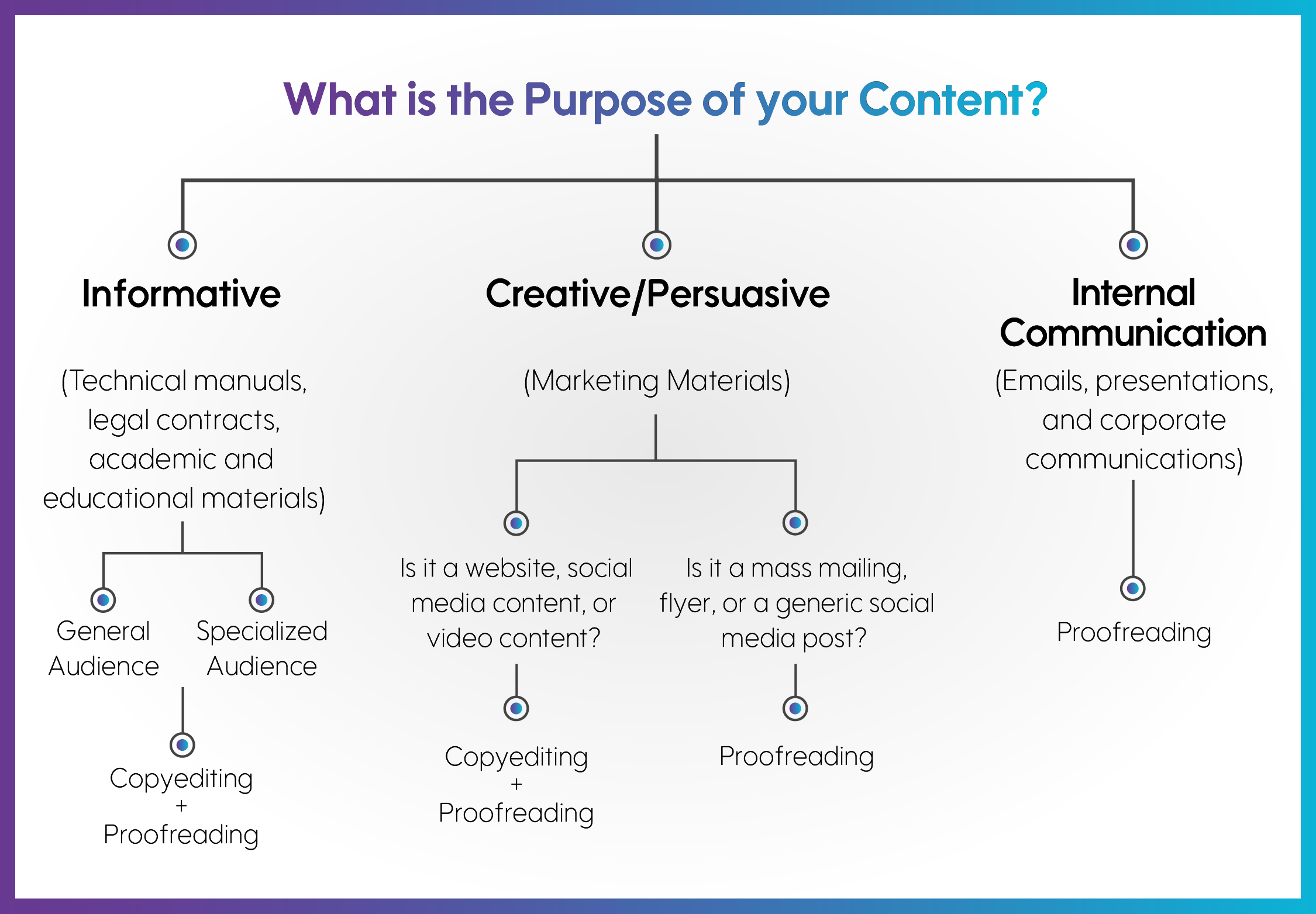Copy Editing vs. Proofreading Explained
Businesses and brands are producing a ridiculously enormous amount of content. Whether you are creating content from scratch or translating your existing content into multiple languages for global exposure, one thing that’s firmly entrenched in the world of content is quality.
The pressure is real now that people have almost zero tolerance for poor or flawed content, let alone if it offends or makes them uncomfortable in any type of way.
In this constant battle for quality, the copy editing vs. proofreading argument arises in every meeting room, often tossed around interchangeably, leaving most uncertain about which service they truly need.
So, what is copy editing? What is proofreading? Which one does your multilingual content need? This article will get into the key differences between proofreading and copy editing, exploring when each one is most effective and whether combining both can offer the ultimate advantage for your business.
Copy Editing vs. Proofreading: The Ultimate Battle for Quality
While content has long been hailed as king, it has been dethroned by quality content. Businesses are technically chasing “quality content”. This shift demands meticulous attention to detail, ensuring every word resonates, builds effective communication, and shapes your brand’s identity.
The truth is bitter but poor content won’t get you anywhere. It won’t build meaningful connections, won’t seal the deal, won’t rank, but will absolutely undermine your business credibility and reputation. These risks are only amplified when translating your content for global audiences.
We’ll try and set this copy editing versus proofreading argument aside and return to it later. For now, we’ll explore 3 crucial quality aspects that demand copy editing or proofreading in the first place. The combination of them all is what categorizes your content as high quality.
What is Copy Editing?
Copy editing, on the other hand, is a specific type of editing focused on improving the clarity, accuracy, consistency, and style of a written text.
It takes place after developmental and line editing but before proofreading. It’s the polishing step before publication by addressing issues at the sentence and paragraph level.
Copy editing addresses the following issues:
- Grammar, Spelling, Syntax, and Punctuation
- Language Usage
- Consistency
- Style and Tone
- Clarity and Readability
Copy editing to editing is like tidying up a room to renovating a house. Copy editing tidies the space while editing overhauls the entire structure.
Copy editing is the process of reviewing and correcting written material to improve clarity, flow, and overall quality. It involves checking for grammatical, punctuation, and spelling errors, ensuring that the text adheres to specified style guidelines, and improving the overall readability.
3 Quality Factors You Can’t Afford to Ignore
- Accuracy: While this may seem obvious, accuracy is a challenging factor of quality. It’s an umbrella factor that basically requires your content to be well-researched, well-written and translated, well-edited, and well-formatted. From factual accuracy and technical precision to linguistic correctness, clarity, and readability, there’s a reason why accuracy comes at the top of the list.
- Cultural Relevance: Does your translated content capture and appeal to the cultural and regional nuances that are unique to your target audiences? If your content is missing relevance, it can be bland and pointless in a way, but if it’s hitting the wrong notes, that would be time for your PR to get ready for a backlash tsunami.
- Brand Identity Consistency: A general rule of thumb is that your brand identity should remain the same across languages and cultures. That’s the power of professional translation. Whether you are communicating with your Spanish or Japanese audience, your translated content should strike that balance of resonating with your diverse audience without your brand losing its personality in the process. This inconsistency breeds confusion and disconnection.
Costly mistakes can arise from even seemingly minor errors. The stakes are high is an understatement.
Inaccurate translations of contracts, financial statements, and training materials, for instance, can have fatal repercussions. Inappropriate or offensive references can severely impact your brand’s reputation globally. Inconsistent language, tone, and messaging across different languages can dilute your brand identity and hinder audience recognition. These can manifest as financial losses, legal repercussions, and reputational damage.
Mistakes will always crawl into your content because we’re all human. But copyediting and proofreading become your safety net against these pitfalls that are likely to cost you more than what you might be hesitant to pay for these services.
Now, that you truly understand the power of copy editing and proofreading. Let’s go back to the copy editing vs. proofreading debate.
Which is Which: Understanding Copy Editing
Before we understand the differences between copy editing and proofreading, there can be a little confusion between them and editing. The three always overlap.
To cut the fluff, both copy editing and proofreading are two types of editing, precisely two different levels of editing. This is one of the things that distinguishes copy editing and proofreading.
What is Editing?
Editing is the broad, all-inclusive term that involves several layers, from checking for factual accuracy to a missing period, and requires multiple sets of eyes. Content editing is an integral part of the writing or translation process that ensures the content meets its intended purpose and audience expectations.

Think of editing as the big-picture approach, where the focus lies on
- Content Organization and Flow
- Clarity and Coherence
- Accuracy
- Cultural Relevance
- Fact-checking and Research
- Readability
- Style and Tone
Which is Which: Understanding Proofreading
While copy editing meticulously polishes the content’s core, proofreading stands as the last line of defense. It’s a final check for errors, scanning for any seemingly minor or tenacious mistakes that still make it through multiple rounds of editing and copy editing.
It focuses on the word, microscopic level, ensuring your content is easy to understand, presented flawlessly, and free from any errors that might distract the reader or detract from the message’s impact.
Proofreading takes place after the copy-editing process and before the content is sent off for print or digital use. The copy editor’s work provides a solid foundation upon which the proofreader builds and puts the final touches to provide a clear, readable, and error-free copy.
Every time you read “Let’s eat Grandma”, think proofreading.

Proofreading addresses the following issues:
- Typos, grammatical errors, punctuation errors, and capitalization
- Formatting: layout or visual inconsistencies
- Inconsistencies in spelling, word choice, or style
- Font styles, margins, spacing, and indentation.
- Cross-references, page numbers, and other internal references.
Drawing on the same example above, proofreading to copy editing is the final touch-up after tidying up, where you use a scent room spray and make sure it’s spotless.
The Difference Between Proofreading and Copy Editing
Let’s put the copy editing vs. proofreading argument to an end. Here’s the final verdict.
| Editing | Copy Editing | Proofreading |
| Big picture: Clarity, overall structure, and flow | Accuracy and Coherence: Structure, Grammar and syntax, style and tone | Surface-level:
Slip-ups, missing content, overlooked mistakes |
| Deepest: Organization and effectiveness | Medium: Paragraph and sentence-level issues | Lightest: Catches and fixes errors and inconsistencies |
| The foundation | The refinement | The finish |
Fun Fact: Did you know that 89.3% of native speakers make spelling mistakes while writing? The number increases to 97.7% for non-native speakers.
Copy Editing and Proofreading in Translation: How Do They Work Together?
Translation is far more complex than it may seem. Navigating cultural nuances and contextual subtleties can be a huge challenge. The translator must delicately balance faithfulness to the original text with clarity and resonance in the translated version, all while navigating the cultural landscapes that underpin each language.
So, it’s perfectly normal for even skilled translators not to get it completely right on the first draft.
Particularly in the context of translation, it’s no longer copy editing vs. proofreading. It’s not a matter of either-or. They intertwine.
TEP: Translation, Editing, and Proofreading
The translation industry relies on a well-established workflow known as TEP, Translation, Editing, and Proofreading. It is a multi-stage process that’s typically implemented for all translation projects and every type of content. Each stage serves distinct yet interconnected roles in refining the final product, acting as a quality control system.
Without editing and proofreading, the quality of your translation is compromised.
Here’s how the TEP process works:
- Translation: Translation acts as the base of the TEP process, which conveys your content from one language (the source language) to another language (the target language).
- Editing: Different but equally qualified editors with expertise in the subject matter and target language carefully read through the translated content and compare it against the original text. Editing involves addressing linguistic, technical, and cultural accuracy as well as consistent adherence to international quality standards and your brand’s guidelines.
- Proofreading: Proofreading comes as an extra layer of editing; a final step to free the translated content from any inaccuracies or mechanical errors that may affect its readability or effectiveness. If any evident issues are identified, the proofreader will collaborate with the translator and editor to address necessary changes. Additionally, proofreaders verify that the translated text’s formatting, layout, and presentation are consistent and adhere to the specified guidelines.
Both copy editors and proofreaders rely on style guides such as the Chicago Manual of Style to ensure adherence to preferred writing styles and English spelling variations as well as industry-specific and brand-specific guidelines.
Copy Editing vs. Proofreading: When to Choose What?
Having explained the differences between copy editing and proofreading, the debate is mostly settled.
If you have a translation project, we even have some good news: you don’t have to choose between copy editing and proofreading.
Editing (copy editing) and proofreading are frequently bundled as complementary services within any translation project. Instead of engaging separate professionals for each task, clients benefit from a cohesive service package. A single solution that saves time and effort as opposed to grappling with multiple vendors.
However, if you are creating content from scratch in one language, it’s time you settle that proofreading vs. copy editing argument once and for all.
Here’s a handy flowchart to help you make the right call.

Sawatech: Expert Copy Editing and Proofreading Services
Sawatech is a professional translation services provider, offering a full range of high-quality language and content solutions across 120 languages. As a crucial part of our quality system, which adheres to the international ISO 17100:2015 certification, we seamlessly integrate editing (copy editing) and proofreading into our translation services, always provided complementary to ensure the highest quality possible. We call it the Sawatech’s 3-tier review process (Translation, Editing, and Proofreading).
But we also provide proofreading and editing as standalone services, available to clients independent of translation projects. Whether you require translation and localization or simply need copy editing and proofreading, our global team of language professionals is here to deliver exceptional quality.
We customize our services to meet your exact needs. Contact us to get started or request your free quote now.




